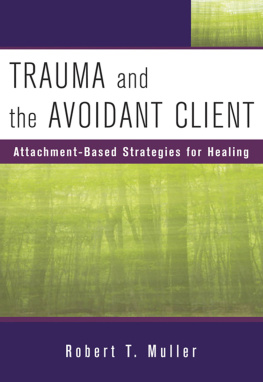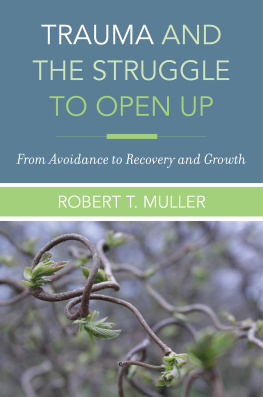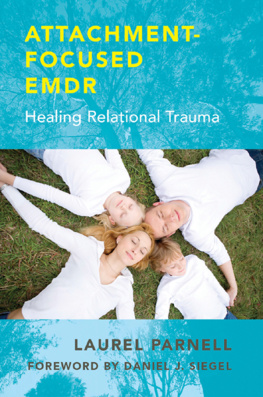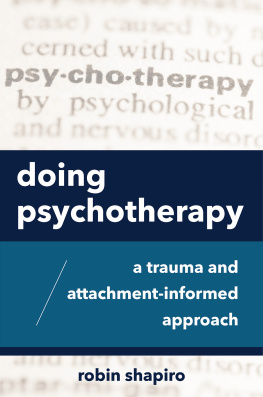TRAUMA and the AVOIDANT CLIENT
Attachment-Based
Strategies for Healing
Robert T. Muller

A NORTON PROFESSIONAL BOOK
W. W. Norton & Company, Inc.
New York London
Copyright 2010 by Robert T. Muller
All rights reserved
For information about permission to reproduce selections from this book, write to Permissions, W. W. Norton & Company, Inc., 500 Fifth Avenue, New York, NY 10110
Library of Congress Cataloging-in-Publication Data
Muller, Robert T.
Trauma and the avoidant client: attachment-based strategies for healing /
Robert T. Muller.1st ed.
p.; cm.
A Norton Professional Book.
Includes bibliographical references.
ISBN: 978-0-393-70696-3
1. Psychic trauma. 2. Avoidance (Psychology) 3. Attachment behavior. I. Title. [DNLM: 1. Stress Disorders, Post-Traumatictherapy. 2. Denial (Psychology) 3. Life Change Events. 4. Object Attachment. 5. Psychotherapymethods. WM 170 M9469t 2010]
RC552.T7M85 2010
616.8521dc22
2009052115
W. W. Norton & Company, Inc., 500 Fifth Avenue, New York, N.Y. 10110
www.wwnorton.com
W. W. Norton & Company Ltd., Castle House, 75/76 Wells Street, London W1T 3QT
To
Diane
And to
Aviva, Aaron, and Noah
For the love, inspiration, and joy they have given
Contents
Acknowledgments
T here are many people who have helped make this book a reality. I credit my treatment approach to the supervision and readings I was exposed to early on in my training. As an undergraduate research assistant for Dr. David Bakan, I first became interested in the field of trauma and psychotherapy. And, as a graduate student in the mid-1980s, I soon imprinted on psychodynamic psychotherapy at Michigan State University, where Dr. Bertram Karons directive approach with very high-risk clients taught me to formulate and work within a psychodynamic framework that engages the individual, builds hope, and values the therapeutic relationship. The writings of Dr. Lester Luborsky (1984) and Dr. David Malan (e.g., 1979/1995) figured heavily into my training at that time. Later, during my postdoctoral fellowship at Harvard University and Massachusetts General Hospital, my clinical supervisors at the time, Dr. Robert Reifsnyder and Dr. Steven Nisenbaum, taught me to formulate within an attachment-based framework. Soon after, the publication of Dr. Judith Hermans Trauma and Recovery in 1992 made a lasting impression on my approach to treatment with survivors of trauma.
I am grateful for the ideas, insights, and feedback that I have received from my colleagues and peers. Dr. Lynn Angus at York University, and Dr. Charles Gelso, editor of the scholarly journal Psychotherapy , provided valuable feedback on the earlier articles on which this book was based. My wife (and colleague) Dr. Diane Philipp spent long hours reading and editing multiple drafts of the book manuscript, as did associate editor Andrea Costella at W. W. Norton. I also benefited enormously from the editorial insights of Dr. Daniel Carlat, publisher and editor of the Carlat Psychiatry Report, and from Steven Muller, L.L.M., who provided a detailed, comprehensive review of the manuscript.
In addition, I would like to thank my friends and colleagues of many years, Dr. Peter Snyder and Dr. Christopher Green, for their insight and guidance regarding the academic book-publishing process. And, I thank Natalie Zlodre, M.S.W., at the Hincks-Dellcrest Centre, for her suggestion several years ago that I put together clinical workshops on the topic of trauma and avoidance and for her helpful guidance in that process.
I am grateful for my graduate students Kristin Gragtmans, Julie Cinamon, Karina Zorzella, Susan Rosenkranz, Ritu Bedi, Cheryl Fernandes, and Lise McLewin for their love of learning, their dedication, and their energetic commitment to this area of research. Thanks also to Adele Newcombe and Zohrah Haqanee who helped find some of the articles used in the literature review.
I would also like to express my gratitude to my clients. I am not sure they realize just how much they have taught me over the years.
Finally, this book is dedicated to my wife, Diane, and to my children, Aviva, Aaron, and Noah. Their love and support have been boundless and unwavering.
TRAUMA and the AVOIDANT CLIENT
Introduction
I dont want to pretend , I dont want to take part in the grand social conspiracy that makes widows tell strangers on the bus that it was his time, or makes parents of buried children say, Well, were just happy we had her for as long as we did, or that in any other way makes any of us pretend that were not furious about the double-edged broadsword of life and death. (Scott Peck, All-American Boy, 1995, p. 91)
T his book begins with a few simple questions. How do you engage the client who pretends, the client who denies and minimizes the effects of her own cruel past? How do you help the vulnerable individual who cannot admit to her own vulnerabilities? How do you work with the trauma survivor who is not so sure that she wants to be helped?
For the clinician who is seeking a therapeutic connection, who is attempting to engage the client, there is no question that such a person is hard to treat. In fact, it may be tempting instead to write off individuals such as these as treatment resistant or to refer them to others. Perhaps this, in part, is why the development of specific intervention strategies for this clinical population has been rather slow moving. Although there is much written about the frustrations of working with such clients, there is far less that can actually be used as a practical guide to treatment.
Earlier in my career, when I was still on faculty at the University of Massachusetts, I attended a talk delivered by a colleague at a meeting of the Society for Family Therapy and Research. Higgins (1994a) described her findings on a group of resilient adults who had managed to overcome the effects of their traumatic histories. I was so intrigued by this talk that the topic of resilience among trauma survivors came to shape my earlier academic interests. A positive sense of the human spirit can be inspiring. However, as I did more and more clinical work with adults who had experienced intrafamilial trauma and as I received training in attachment theory and assessment, I came to realize that the story is actually much more complicated than I had previously thought: A good many trauma survivors pretend to be doing a lot better than they really are. They pretend for years on end. They pretend for others, and they pretend for themselves. And, the individual who pretends to be okay (but who is otherwise in need of help) is in fact hard to treat.
This book is about the psychotherapy of trauma. Attachment-related traumatic experiences, intrafamilial abuse or neglect, and traumatic losses are the primary traumatic stressors considered. In each of the cases presented, an important trust has been violated. Thus, fundamental to this work is the development of a strong therapeutic alliance to ultimately help the client regain a sense of trust in others. The treatment approach is attachment oriented and psychodynamic. It uses the therapeutic relationship as a means of understanding the individuals relational difficulties and compensatory mechanisms. The client is encouraged to take interpersonal risks, to express feelings he would normally keep buried, to mourn losses, to face his vulnerabilities. A lot of personal digging is asked of the clinician as well. One of the more dense chapters (Chapter 6) focuses on therapist countertransference. Treatment choices in this work are often mediated by the clinicians own attachment history and pattern of vulnerability.













